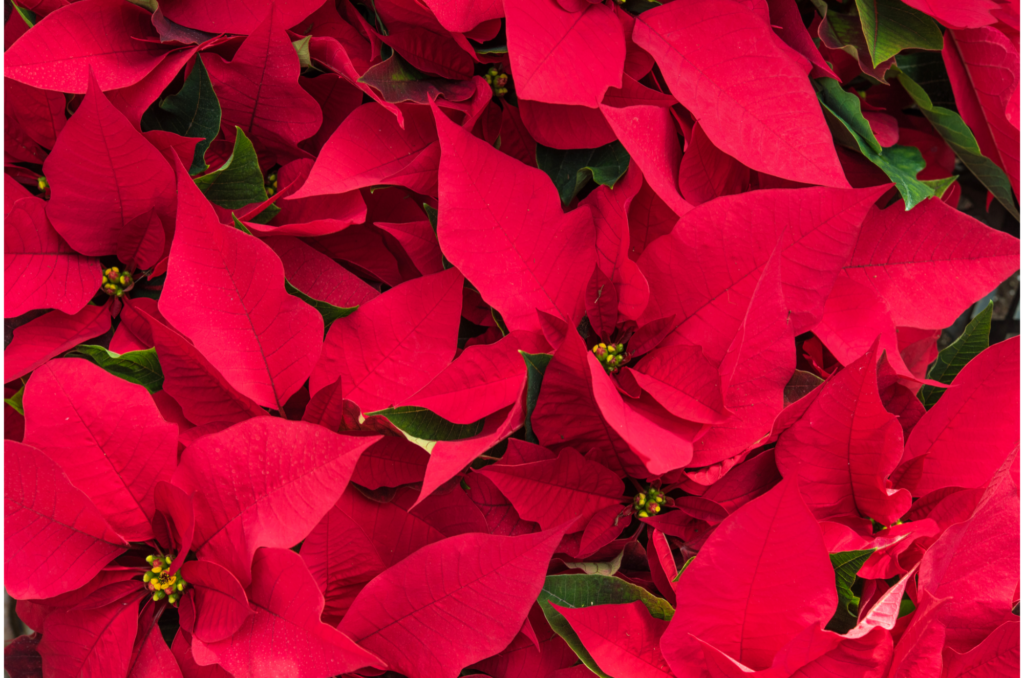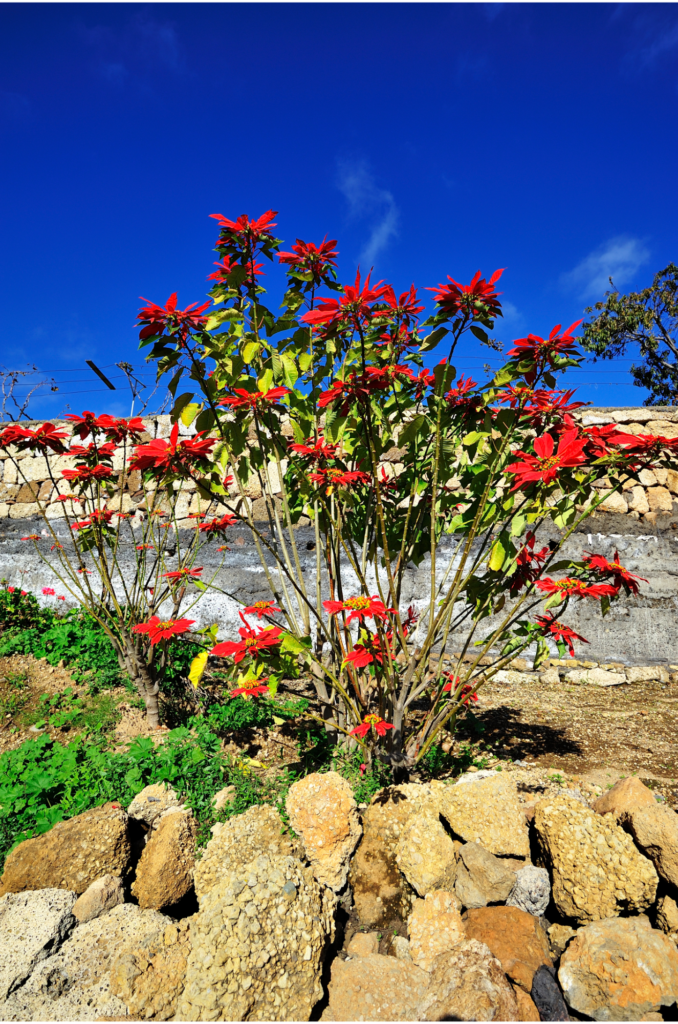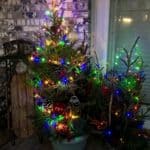The most common questions I get every holiday season relate to caring for poinsettias. Actually, it usually begins with a panicked outreach as to why their once beautiful holiday plant is suddenly droopy, dropping leaves or just downright mad. With just a few easy tips and a bit of knowledge, your festive plant can look fantastic well beyond the holiday season.

History
Let’s start with a little background. You know I’m a history buff and couldn’t resist diving into the background of this most interesting plant. I knew it was a tropical plant, but was there more to this story? The answer – a lot more! Poinsettias are a traditional Christmas flower throughout much of the world. The poinsettia is a member of the spurge family. This colorful plant was discovered near the present-day city of Taxco, Mexico in southern Mexico. The plant we all think of as an indoor houseplant grows to be a very large woody shrub in its native region of Mexico and Central America, often growing to more than 10 feet tall. Can you imagine seeing it’s red glory of this giant shrub in the wild?

Ancient Aztec Indians regarded poinsettia as a symbol of purity in addition to practical uses. The red leaves of the poinsettia, known as bracts, were used to make a deep red-purple dye used in cosmetics and textiles. During the 17th century, Spanish Franciscan priests in Mexico used poinsettia in nativity processions. Why? It was simply a matter of practicality. It was a traditional holiday color and it was in bloom in December.
Poinsettias first arrived in the United States in 1825. Joel Roberts Poinsett, the first ambassador to Mexico, delighted in the plant’s red blooms. He sent some of the plants to his home in South Carolina. Poinsett happened to be a skilled botanist and propagated the plants. He began giving the plants away to friends, family and to botanical gardens. Within a few years, the plants reached Robert Buist, a nursery owner, who is believed to be the first person to sell the plant in the United States. In 1833, this plant who’s formal name is Euphorbia pulcherrima, was graced with the common name, poinsettia, in honor of Joel Poinsett. Today, the arrival of poinsettias signals that the holiday season has arrived.
The modern day poinsettia has been hybridized and engineered, creating many varieties. This cultivating has successfully produced plants with larger, longer lasting bracts (leaves). Colors now include cream, peach, pink, salmon, yellow and marbled. The traditional red poinsettia accounts for more than 70% of annual sales.
Did you know that Congress declared December 12 to be National Poinsettia Day? Why December 12? The day honors Joel Poinsett who died December 12, 1851. Imagine, without Poinsett’s efforts, we’d never have such a lovely holiday fixture. So on the next December 12, have fun with this interesting history by surprising a friend with a lovely poinsettia.

Caring for poinsettia
The poinsettia “flowers” are not flowers at all. As mentioned, they are leaves called bracts. The small yellow flowers in the center are called cyathia. Contrary to the myth, poinsettias are not seriously harmful to humans or animals, but they shouldn’t be eaten. They have only a mild toxicity when ingested, including to pets. Large amounts ingested may result in stomach issues like vomiting or diarrhea, very likely not fatal. As one veterinarian put it, your pet would need to eat the entire plant to get seriously ill. In the unlikely event this happens, do call your vet just to be safe. Enjoy your poinsettia and use normal best practices to keep pets and kids out of the plants.
Free the plant from the foil! This tip deserves a special mention. Not unique to poinsettias, the dreadful foil that is often wrapped around decorative plants when they are sold brings certain death to your plant if not removed. The foil blocks drainage holes, causes pooling in the pot and eventual root rot. Get that foil off of there. When people send me pics of their sick plants, many times there’s that “lovely” foil sparkling back at me. Lose the foil. Your plant will thank you. An easy way to keep your pot cute is to just slip the plant, nursery pot and all, into a slightly larger and more stylish pot. Just make sure your pot of choice has a drainage hole or holes. If grown inside, don’t forget to add a drip tray underneath the pot to prevent a mess when the water drains through your soil. Dump any extra water than might be standing in the drip tray.
Ok, now that I’m off my foil soapbox, on to more tips!
As an Amazon Associate I earn from qualifying purchases.
Light (indoors): put your plant in a south, east or west window where the plant can receive bright daylight. Do not put your poinsettia right up against a window. The bracts could get sun scald (especially in a South window), but more likely in cold regions, your poinsettia can literally get bit by the cold. Those glass windows get very cold, even to freezing, in northern climates. Provide the bright light from your window, at a distance that gives a buffer preventing direct glass contact.
Light (outdoor): Part-sun, four to six hours daily. If you’re lucky to live where temperatures stay above 55 degrees year round, you can grow your poinsettia outside always and achieve that amazing 10 foot shrub. For us northerners, once it’s nice and warm and all danger of frost has past, usually in May in the midwestern United States, your poinsettia can enjoy time outside in its pot until temps cool off again.
Temperature: 65 to 72 degrees Fahrenheit will make for a happy plant. Keep your poinsettia away from drafts, cold, direct heat sources, including vents. Poinsettias will be damaged at temperatures below 50 degrees and even a light frost will kill the plant.
Something often overlooked is the automatic thermostat adjustment that many offices use, sending the temperatures plummeting during nights and weekends. Your once lovely poinsettia on Friday may be near death on Monday if you don’t consider temperature fluctuations that may be beyond your control. If you know this is going to occur, you should definitely enjoy your poinsettia at home. When transporting the poinsettia outside in cool temperatures below 50 degrees, cover it with a bag until you get back inside. Do not leave it in a cold car.
Water: Keep the soil moist. Water the plant when the soil feels dry to the touch on the surface. If you let your poinsettia soil completely dry, it will wilt. Make sure your pot drains freely. One great approach is to put your plant in the sink (without the drip tray) when you water it deeply. Let the plant sit in the sink until it has completely drained.
Fertilizer: You don’t need to fertilize your poinsettia during the holiday season. In fact, if you just acquired it, the plant has already been regularly fertilized. Like other houseplants, backing off of fertilizer during the winter months is a good thing and resuming again in early spring. Once you see new growth, stems or bracts start fertilizing with an all-purpose houseplant fertilizer. Dilute the fertilizer with water to half the recommended strength. Feed every three to four weeks.
Transplanting: For the majority of folks enjoying a poinsettia, the plant is often treated like an annual holiday plant that stays in the pot it arrived and is ultimately tossed. With fertilization, it can stay lovely and “in bloom” well into January. Have no guilt if you treat yourself to a new plant each year, but if you like a challenge, try preparing your plant for long duration and eventual annual rebloom. The first step in that process is to transplant your poinsettia in the spring. In a pot, select a planter that is two to four inches larger than the original pot. Use a quality potting soil and a pot with good drainage. Water your plant thoroughly after transplanting. Your poinsettia will love living outside in it’s pot once all danger of frost has passed. You can even plant it in the garden and lift it again in the fall. Either way, if your plant is headed outside, place it in a location that gets 4 to 6 hours of sun daily. Let’s dig into the details a bit further.
Reblooming: Here’s where things get interesting. Encouraging a poinsettia to rebloom is not an easy task, requiring following a schedule and withholding light all the while keeping the plant healthy. Withholding the light is the key to getting colorful bracts. Honestly I’ve never tried it. I generally take the easy path, the lazy girl gardening approach you might say. If you’re feeling ambitious, here are the steps to do it successfully. This plan follows the holidays to make it easier to keep track of.
- New Year’s Day – fertilize at half strength if you’re seeing new growth. Continue to provide adequate light for prolonged bloom for several weeks.
- Valentine’s Day – if your plant has become long and leggy, cut it back to five inches tall to promote compact growth.
- St. Patrick’s Day – prune off faded leaves or dried parts of the plant. Remove lower leaves near the soil surface. Add more potting soil if roots are visible. Continue growing the plant in a bright, sunny window.
- Memorial Day – trim off two to three inches of branches to promote side branching.
- Father’s Day – move the plant outside for the summer and place in indirect light or plant directly in the garden.
- Fourth of July – trim the plant again and move into full sun. Continue to water and fertilize, increasing fertilizer to full strength.
- Labor Day – move indoors to a spot that gets a minimum of six hours of direct light daily, ideally more. As new growth begins, reduce fertilizer to one-quarter of recommended strength.
- Fall equinox – starting near the third week in September. This is where the work begins.
- Darkness/daylight rotation – give the plant 16 hours of complete darkness like a closet, basement or even under a box, followed by eight hours of bright light every day. During the darkness period, the plant cannot receive even the slightest bit of light. For example, if your plant is in the basement, be sure to cover the basement windows.
- Cool temperatures – maintain temperatures in the low 60 degree F range.
- During the daylight hours, rotate the plant a quarter turn each day to ensure the plant receives light evenly on all sides.
- Thanksgiving
- Discontinue your long night/short day conditions.
- Place the plant in a sunny window receiving at least 6 hours of bright light daily.
- Reduce water and fertilizer.
- Christmas – enjoy your poinsettia and repeat the process annually. Congrats! You are a patient, devoted poinsettia owner. That’s a very cool achievement.
Enjoy your poinsettia, a true holiday tradition!




